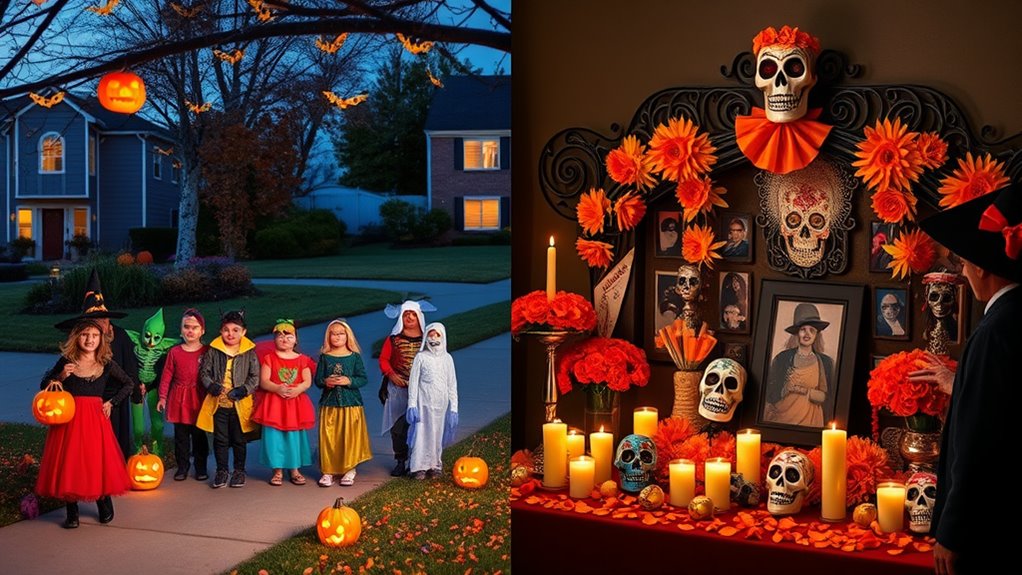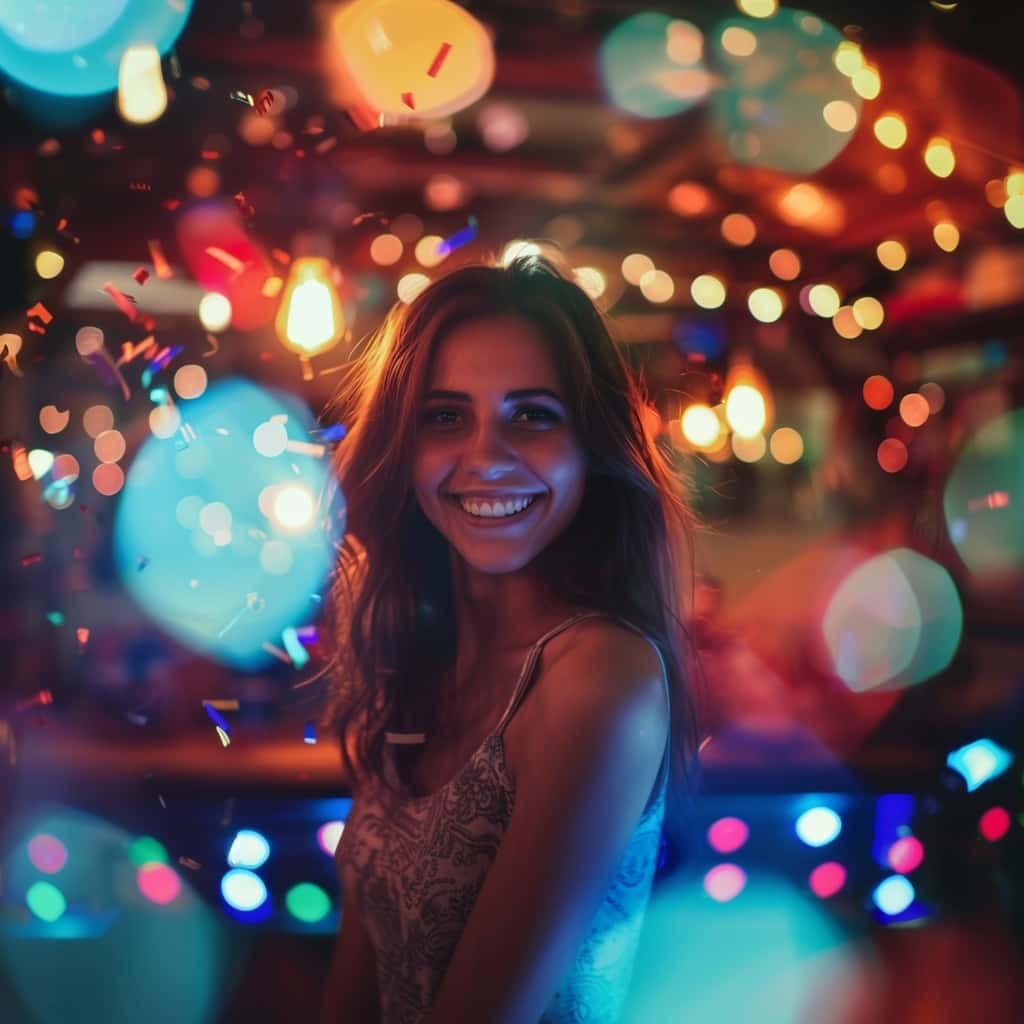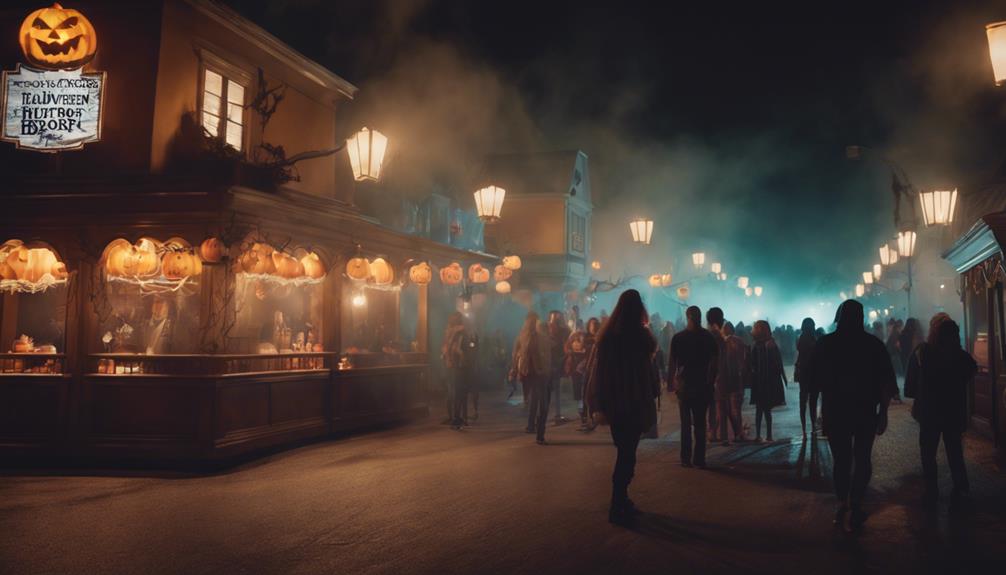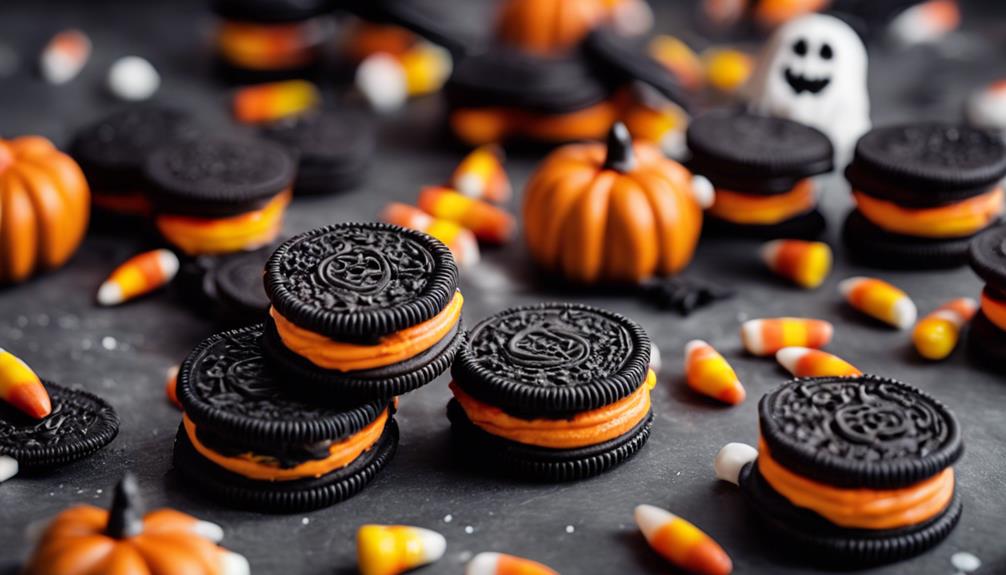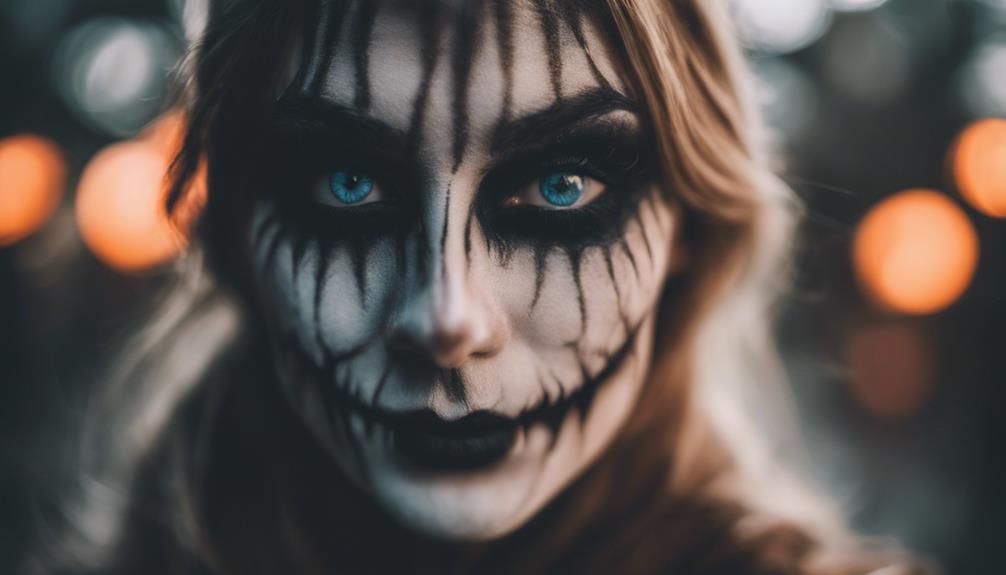Halloween and Día de Muertos have different origins—one from Celtic traditions and the other from Mexican indigenous beliefs—each with unique customs, symbols, and foods. Halloween focuses on costumes, spooky imagery, and warding off spirits, while Día de Muertos celebrates loved ones with vibrant altars and offerings. Respectful participation means understanding these differences and appreciating their cultural significance. If you continue exploring, you’ll gain a deeper understanding of how to honor each tradition authentically.
Key Takeaways
- Halloween originated from Celtic Samhain, emphasizing warding off spirits, while Día de Muertos celebrates honoring and remembering ancestors.
- Halloween features costumes and spooky symbols like pumpkins and ghosts; Día de Muertos uses vibrant skulls, marigolds, and altar offerings.
- Respectful observance requires understanding each tradition’s cultural roots and avoiding stereotypes or appropriative costumes.
- Participating in community-centered activities and learning about their significance fosters genuine cultural appreciation.
- Digital platforms facilitate cross-cultural exchange, promoting respectful understanding of each celebration’s spiritual and cultural importance.
Origins and Historical Backgrounds
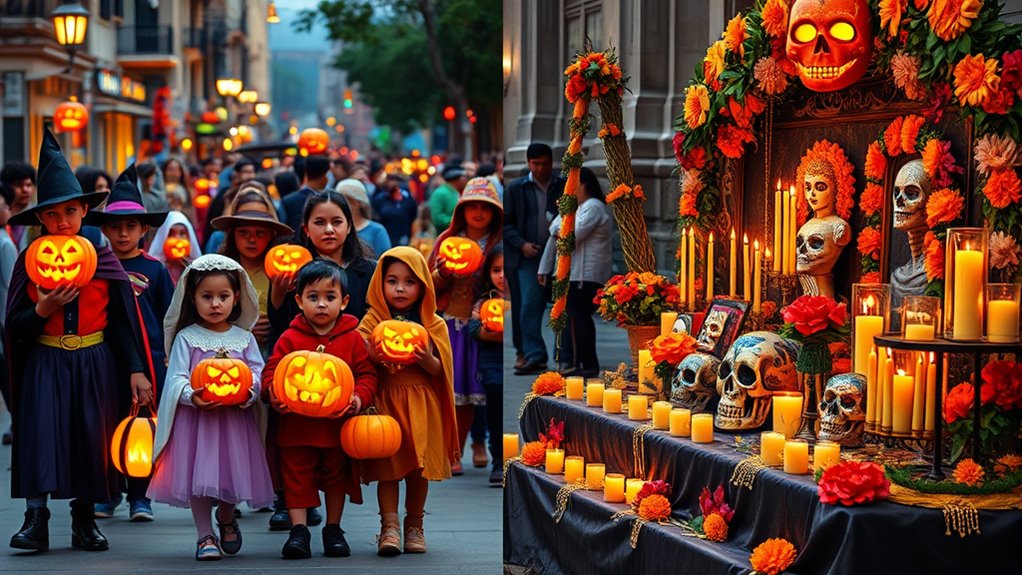
Both Halloween and Día de Muertos have deep roots in history, but their origins reflect different cultural traditions. Halloween originates from ancient Celtic folk practices, particularly Samhain, a festival marking the end of harvest and honoring the dead. It was believed that during Samhain, the boundary between the living and spirits blurred, influencing customs like bonfires and costumes to ward off ghosts. Over time, these pagan traditions merged with Christian influences, evolving into Halloween. In contrast, Día de Muertos has religious origins rooted in indigenous Mexican beliefs. It celebrates the cycle of life and death, with rituals honoring ancestors through altars and offerings. Both traditions serve as ways to connect with the spiritual domain, but their roots highlight distinct cultural perspectives on death and remembrance.
Cultural Significance and Underlying Themes
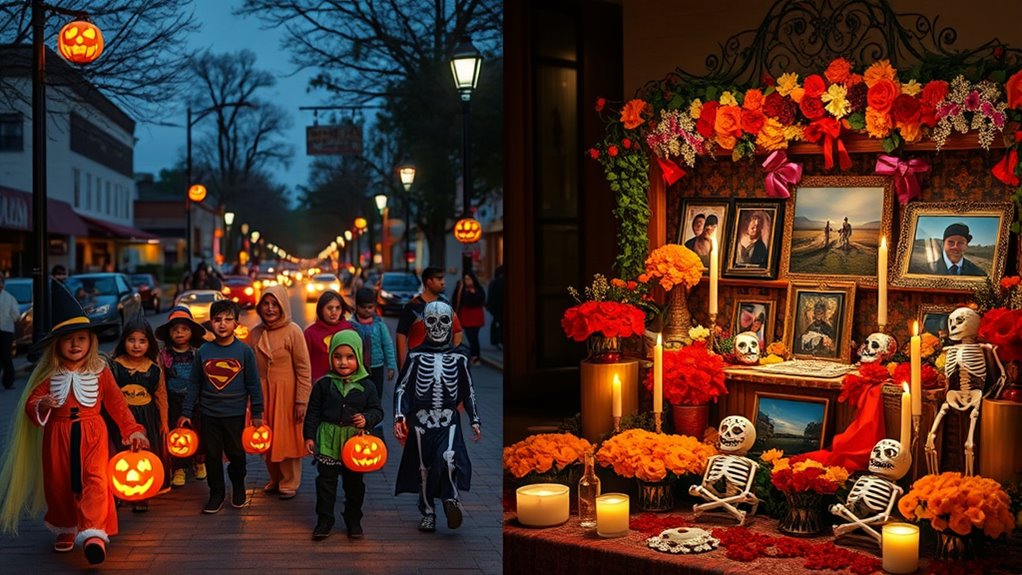
Halloween and Día de Muertos each carry profound cultural significance by reflecting how different societies view life, death, and remembrance. Halloween’s spiritual symbolism often centers on honoring spirits, warding off evil, and celebrating the supernatural, emphasizing themes of transformation and mystery. Día de Muertos, on the other hand, firmly embraces cultural preservation, honoring ancestors with altars and offerings that keep family histories alive. Both traditions serve as a means to connect the living with those who have passed, but they do so through distinct underlying themes. Halloween highlights the playful and eerie aspects of death, while Día de Muertos emphasizes respect, continuity, and the enduring bond between generations. These themes deepen your understanding of each celebration’s unique approach to mortality and memory. Additionally, the use of digital platforms in modern celebrations, especially in virtual environments or remote hackathons, showcases how technology can facilitate cultural exchange and remembrance across borders.
Traditional Celebrations and Customs
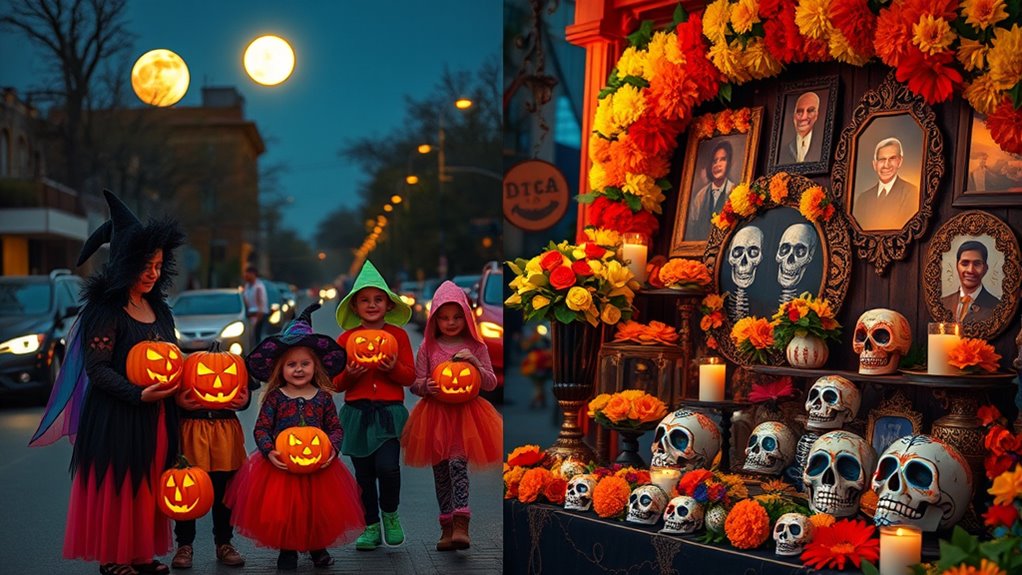
You’ll notice that Halloween costumes often feature spooky or playful themes, while Día de Muertos altars are decorated with photos, marigolds, and personal mementos. Traditional foods and offerings, like candy or pan de muerto, also play a key role in both celebrations. These customs help express respect for the dead and create meaningful ways to honor loved ones. Additionally, cultural significance plays a vital role in shaping how each holiday is celebrated and understood.
Halloween Costumes and Themes
On Halloween night, people of all ages dress in costumes that reflect spooky themes, popular characters, or creative ideas. You might see witches, vampires, superheroes, or even funny outfits. However, it’s important to be aware of cultural appropriation, which can happen when costume stereotypes reduce complex cultures to simple, inaccurate images. Avoid dressing in costumes that perpetuate stereotypes or disrespect traditions. Instead, opt for creative, respectful choices that celebrate your interests without misrepresenting others. Themes often focus on horror, fantasy, or humor, but being mindful of cultural sensitivity ensures everyone can enjoy Halloween safely and respectfully. Remember, costumes should be fun and inclusive, not offensive or stereotypical. Your choices can make the celebration enjoyable for all. Additionally, choosing culturally sensitive costumes helps promote respect and understanding among diverse communities.
Día De Muertos Altars
Día de Muertos altars are vibrant displays that honor and remember loved ones who have passed away. The altars’ significance lies in their role as a heartfelt tribute, inviting spirits back for a brief reunion. When constructing an altar, you’ll see carefully arranged layers, often decorated with photographs, candles, marigolds, and personal mementos. Each element has a purpose, symbolizing different aspects of life, death, and remembrance. The construction of the altar reflects respect and love, blending tradition with personal touches. You might include favorite items of the departed and religious symbols, emphasizing the importance of family and community. Altars serve as a powerful reminder of bonds beyond death, making the celebration both meaningful and deeply cultural. Incorporating traditional symbols and decorations helps convey the cultural significance of the celebration.
Traditional Foods and Offerings
Traditional foods and offerings play a central role in Día de Muertos celebrations, serving as a way to honor and nourish the spirits of loved ones. These offerings are rich in cultural symbolism, with items like sugar skulls, pan de muerto, and favorite foods of the departed arranged on altars. You’ll notice that ritual practices emphasize the significance of these foods, not just as sustenance but as a meaningful connection to ancestors. Each item reflects respect and remembrance, often chosen with care to represent specific loved ones. The act of preparing and presenting these offerings embodies cultural values and spiritual beliefs, transforming food into a powerful symbol of life, memory, and continuity. Additionally, traditional offerings often include cultural symbols, which deepen the spiritual significance of the altars and reinforce community bonds. This tradition highlights the deep respect for ancestors ingrained in Día de Muertos customs.
Symbolism and Iconography
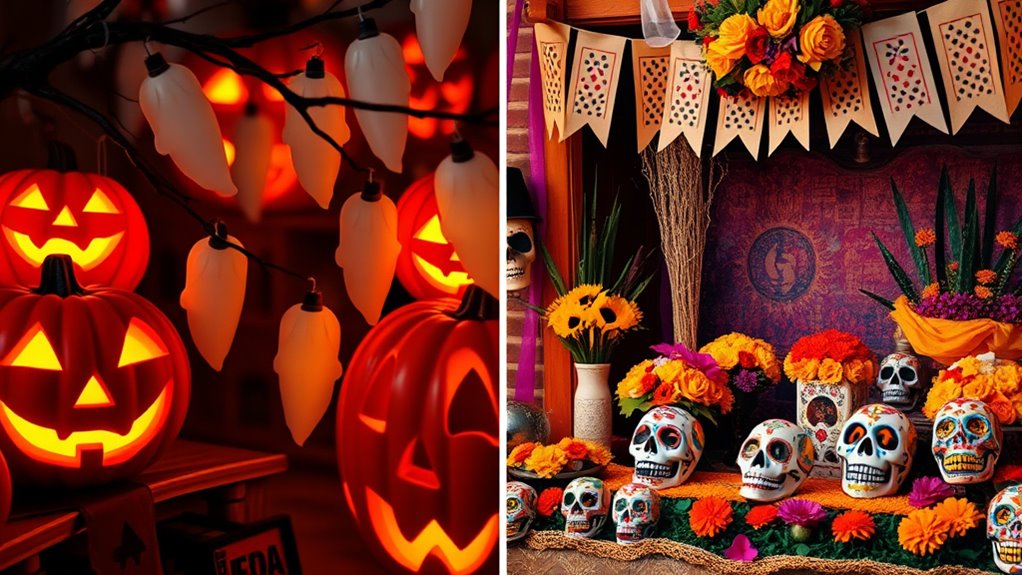
You’ll notice that both celebrations use powerful symbols that carry deep meanings. Halloween features icons like pumpkins and ghosts, while Día de Muertos showcases decorated skulls and altars. These visual traditions and art forms help express cultural beliefs and honor loved ones in unique ways. Incorporating antique elements into decorations can also add a layer of historical significance and authenticity to the observances.
Iconic Symbols and Meanings
Halloween and Día de Muertos each feature distinctive symbols that carry deep meaning and reflect their cultural roots. You’ll notice that sugar skulls represent the departed’s spirits in Día de Muertos, often decorated with bright colors and intricate designs. Marigold petals are used to guide spirits to their altars, symbolizing the fragility of life and death. Halloween, on the other hand, features symbols like pumpkins and black cats, which evoke mystery and protection against evil spirits. These symbols serve as visual reminders of each tradition’s origins and beliefs. Here’s a quick comparison:
| Symbol | Meaning |
|---|---|
| Sugar skulls | Honoring the dead, celebrating their lives |
| Marigold petals | Guiding spirits, representing life’s fleeting nature |
| Pumpkins | Warding off evil, harvest celebration |
| Black cats | Superstition, protection against harm |
Additionally, the use of cultural symbolism in both observances highlights their unique ways of honoring the deceased and invoking protection.
Visual Traditions and Art
Have you ever noticed how the visual styles of Halloween and Día de Muertos vividly reflect their cultural significance? Both celebrations use symbolic imagery and artistic expressions to honor their traditions. For example: 1. Bright calaveras (skulls) and marigold flowers in Día de Muertos symbolize life, death, and remembrance. 2. Spooky pumpkins and ghosts in Halloween highlight fear and the supernatural. 3. Color palettes differ—Día de Muertos favors vibrant, warm hues representing vitality, while Halloween uses darker tones to evoke mystery. These artistic expressions aren’t just decoration; they embody deeper meanings about mortality, spirituality, and cultural values. Additionally, the symbolism in pottery created by the Hopi Tribe reflects similar cultural values and spiritual beliefs expressed through their artistic traditions. By understanding these symbolic imagery and visual traditions, you gain insight into how each celebration respectfully honors its history and beliefs through compelling art.
Typical Foods and Offerings
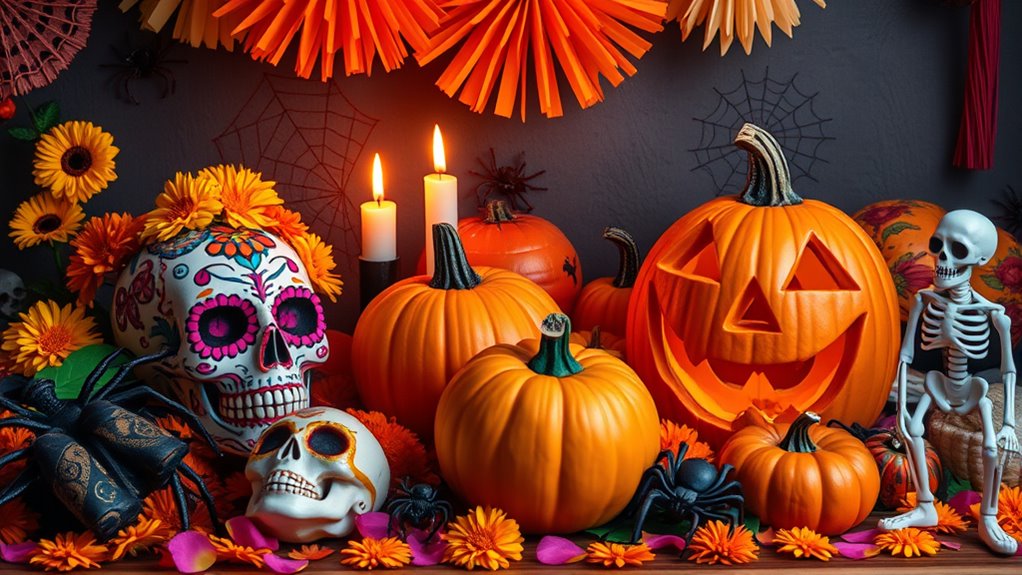
During Halloween and Día de Muertos, the foods and offerings each community prepares hold deep cultural significance. These culinary traditions reflect their unique cultural symbolism and spiritual beliefs. For Halloween, you might find treats like candy apples, pumpkin-shaped cookies, and themed candies, emphasizing fun and mystery. Día de Muertos, on the other hand, features traditional foods such as pan de muerto—sweet bread symbolizing the cycle of life—and sugar skulls that honor departed loved ones. You’ll also see seasonal fruits, tamales, and favorite dishes of the deceased placed on altars. These offerings serve as a way to remember and connect with loved ones, celebrating their lives with meaningful, culturally rich foods that embody respect and remembrance. Cultural significance is central to understanding the importance of these culinary traditions and their role in honoring the deceased.
Community Involvement and Public Events
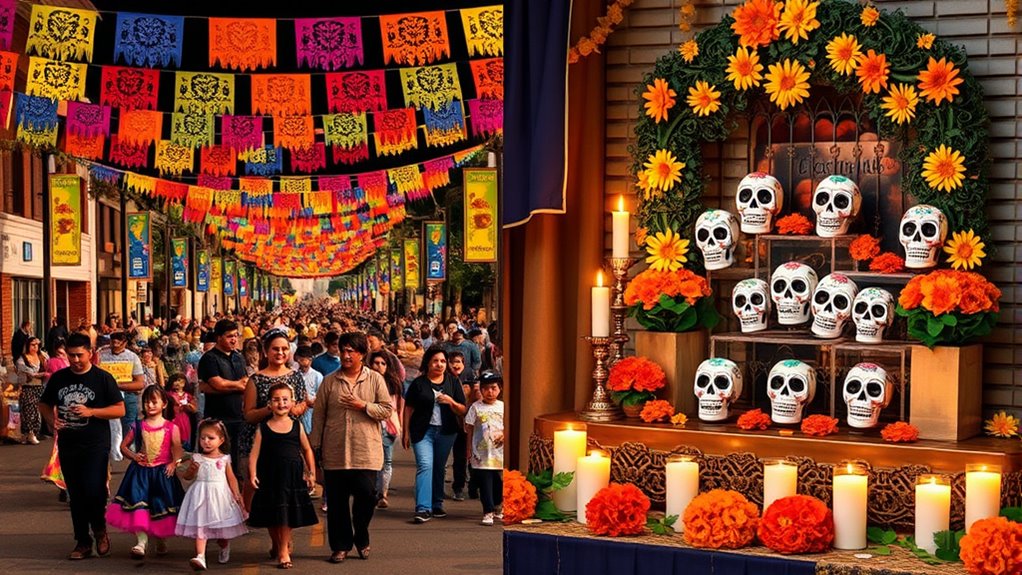
Community involvement plays a vital role in shaping the vibrant public events that mark both Halloween and Día de Muertos. Your engagement influences how these celebrations reflect cultural values and foster connection. When participating in event organization, consider these key aspects:
Community involvement shapes meaningful Halloween and Día de Muertos celebrations through active participation.
- Encourage inclusive community participation to honor diverse traditions.
- Promote local artisans and performers to showcase cultural heritage.
- Support educational activities that deepen understanding of the celebration’s significance.
- Emphasizing the importance of community involvement can lead to more meaningful and respectful observances.
Respectful Appreciation and Cultural Sensitivity
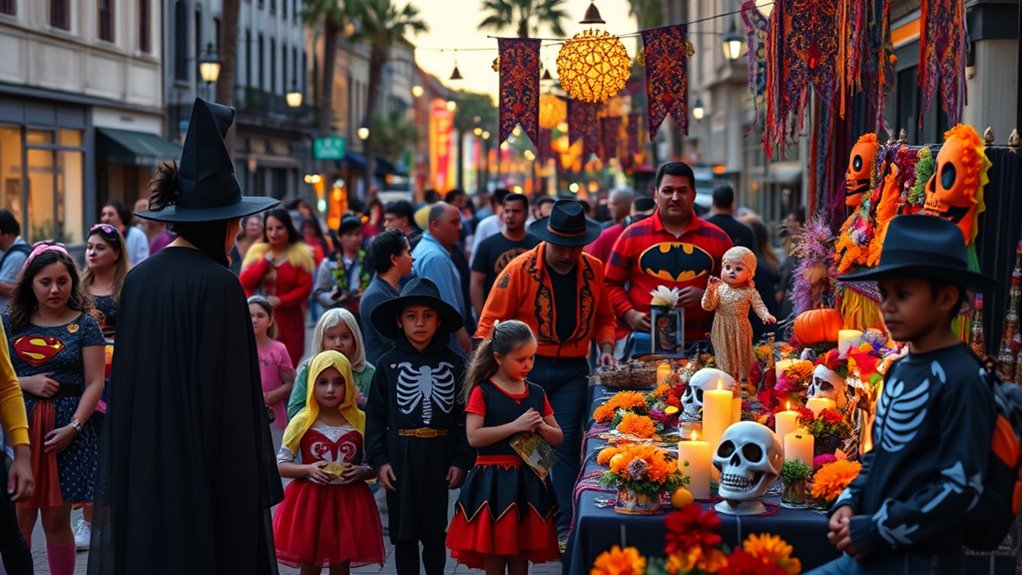
Understanding and respecting the cultural roots of Halloween and Día de Muertos is essential when participating in or organizing celebrations. You should approach each tradition with cultural sensitivity, recognizing its significance beyond costumes and decorations. Respectful appreciation involves learning about the origins, meanings, and customs associated with these festivities, rather than appropriating them superficially. When engaging with Día de Muertos, honor the symbolism behind altars and offerings, and avoid trivializing or misusing cultural elements. Similarly, when celebrating Halloween, acknowledge its historical background and avoid stereotypes. Your awareness and thoughtful participation help foster genuine respect, ensuring these cultural expressions are preserved with dignity. By prioritizing cultural sensitivity and respectful appreciation, you contribute to a more inclusive and meaningful celebration for everyone involved. Additionally, understanding the growth of cultural awareness around these traditions can promote more authentic and respectful observances.
Common Misconceptions and How to Avoid Them
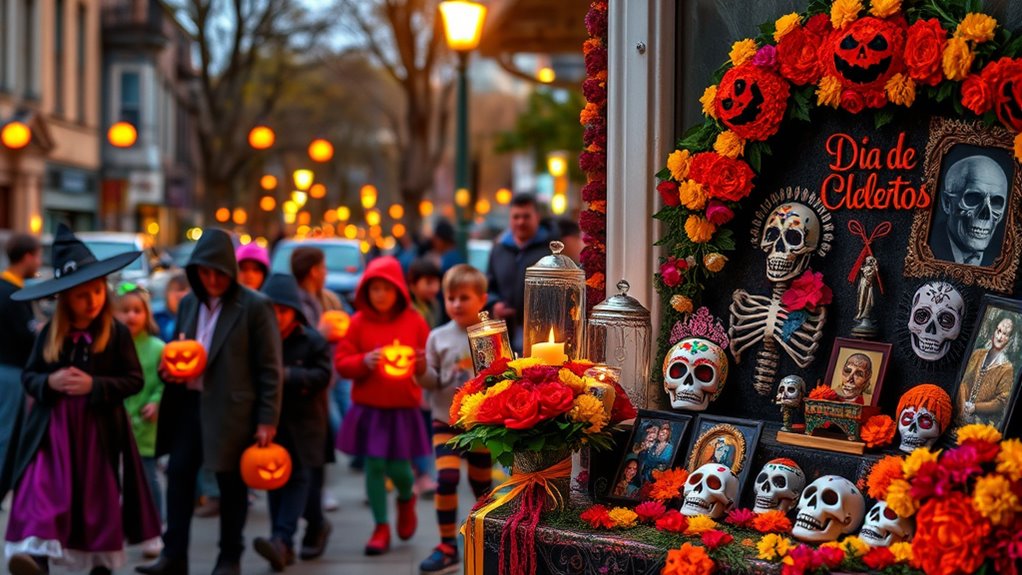
Many misconceptions about Halloween and Día de Muertos persist, often leading to disrespectful or superficial portrayals of these rich traditions. To avoid this, it’s essential to recognize the importance of respecting cultural differences and avoiding stereotyping. Here are key ways to stay respectful:
- Educate yourself about each celebration’s history and significance.
- Refrain from using costumes or symbols that promote cultural appropriation.
- Support authentic expressions rather than commercialized or misrepresented versions.
- Recognize that both holidays involve cultural practices that hold deep spiritual and communal meaning.
Understanding these points helps prevent reducing complex cultural practices to trivial stereotypes. By approaching both holidays with curiosity and respect, you honor their true meanings and avoid perpetuating harmful misconceptions. This mindful approach fosters appreciation rather than misrepresentation, ensuring these traditions are celebrated with dignity.
Frequently Asked Questions
How Do Halloween and Día De Muertos Influence Modern Pop Culture?
You see how Halloween and Día de Muertos influence modern pop culture through costumes, movies, and music. They inspire creative adaptations, blending traditional symbols like skeletons and altars with contemporary themes. This influence shapes popular events, merchandise, and media, making these celebrations more widely recognized. Their impact encourages respect for cultural traditions while also fostering innovative, modern adaptations that keep these customs relevant and engaging for diverse audiences.
Are There Religious Aspects Intertwined With Each Celebration?
You might find it a coincidence, but both celebrations do carry religious significance. Halloween has roots in Christian and pagan traditions, emphasizing themes like saints and spirits. Día de Muertos, deeply rooted in spiritual beliefs, honors deceased loved ones with offerings and prayers. These rituals reflect their respective religious ties, showing respect and remembrance, so understanding their spiritual aspects helps you appreciate the cultural depth behind each celebration.
How Do Different Regions Within Mexico Observe Día De Muertos?
You’ll notice regional variations in how Mexicans observe Día de Muertos, reflecting local customs and traditions. In Oaxaca, you might see elaborate altars and vibrant parades, while in Michoacán, the focus is on intricate craftwork like painted skulls and decorated graves. In some areas, community activities and traditional dances play a big role, making each region’s celebration unique and deeply rooted in local culture.
What Role Do Children Play in Each Holiday’s Festivities?
Children play a crucial role in both holidays’ festivities. During Halloween, you might see kids participating in trick-or-treating and costume contests, making it lively and playful. In Día de Muertos, children often help decorate altars and gather marigolds, engaging in festive activities that honor ancestors. Their participation fosters cultural understanding and keeps traditions alive, creating a joyful atmosphere that connects generations.
How Can Outsiders Respectfully Participate in Día De Muertos Traditions?
Respectfully participate in Día de Muertos by practicing cultural sensitivity and showing sincere interest. You can honor traditions by learning about and respecting altar offerings, understanding their significance, and avoiding inappropriate practices like commercialization. Support local artisans, attend community events with reverence, and ask permission before engaging. By embracing these respectful gestures, you demonstrate genuine respect and appreciation for the rich, sacred customs of Día de Muertos.
Conclusion
By truly understanding the differences and respecting each tradition, you could become a cultural ambassador, bridging worlds with just your appreciation. Embracing Halloween’s spooky fun or Día de Muertos’ heartfelt remembrance isn’t just about costumes or candies—it’s about honoring histories so rich, they could fill libraries. So, immerse yourself with respect and curiosity, and you’ll discover the secrets of these vibrant celebrations, transforming your perspective from an outsider to a true cultural connoisseur!
